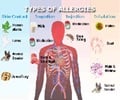A mouse model that can actually portray the symptoms of peanut allergy has been developed by researchers from Chicago.<
A mouse model that can actually portray the symptoms of peanut allergy has been developed by researchers from Chicago.
According to the experts at the National Institute of Allergy and Infectious Diseases (NIAID), the new animal model will help in understanding the causes of peanut and other food allergies and in finding new ways to treat and prevent their occurrence."Finding an animal model that mimics a severe human allergic reaction to peanuts will help us better understand peanut allergy and develop new and improved treatment and prevention strategies," said NIAID Director Anthony S. Fauci, M.D.
Allergic reactions to food can range from mild hives to vomiting to difficulty breathing to anaphylaxis, the most severe reaction. Anaphylaxis may result from a whole-body allergic reaction to the release of the chemical histamine, causing muscles to contract, blood vessels to dilate and fluid to leak from the bloodstream into the tissues.
These effects can result in narrowing of the upper or lower airways, low blood pressure, shock or a combination of these symptoms, and also can lead to a loss of consciousness and even death.
The research team led by led by Paul Bryce, Ph.D., of the Feinberg School of Medicine at Northwestern University fed the mice with a mixture of whole peanut extract (WPE) and a toxin from the bacteria Staphylococcus aureus, called staphylococcal enterotoxin B (SEB) to simulate the human anaphylactic reaction to peanuts in mice.
"Persistent S. aureus colonization is commonly found on the skin of people with eczema and in the nasal cavities of people with sinusitis," said Dr. Bryce.
Advertisement
The researchers showed that the SEB/WPE mixture stimulated severe symptoms in mice that closely resemble those found in human anaphylaxis, including swelling around the eyes and mouth, reduced movement and significant problems breathing.
Advertisement
The study appears in the Journal of Allergy and Clinical Immunology.
Source-ANI
SAV










